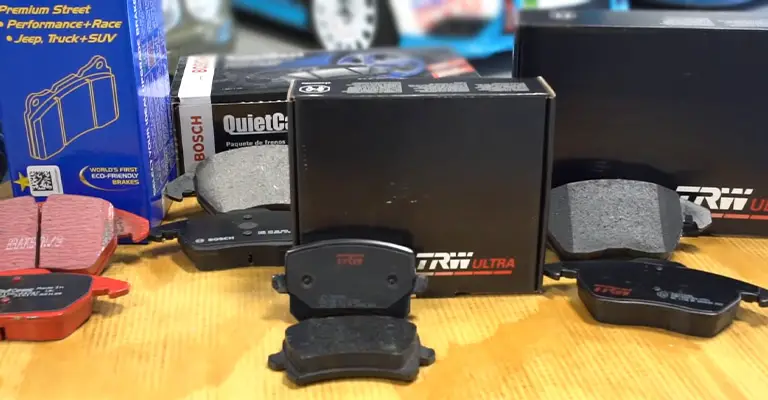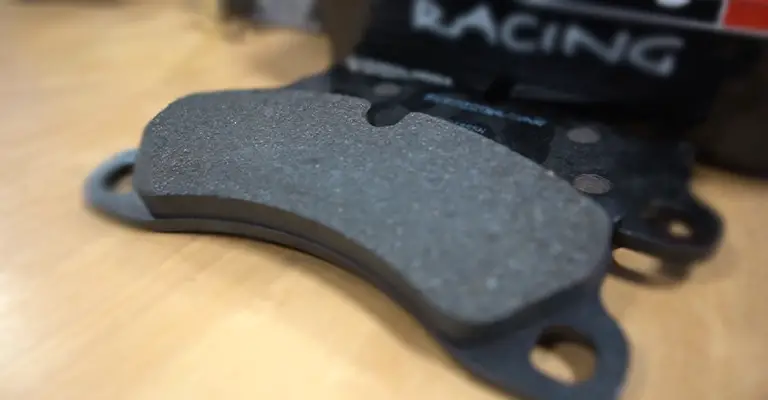Semi-metallic or carbon metallic pad will have great stopping performance. On the contrary, a softer organic pad will be quiet but will wear out quickly. A ceramic pad will be quiet and have a long life, but it cannot handle the heat of extreme braking
Contents
What makes a good brake pad
When choosing a brake pad we consider some qualities like the ability to absorb and disperse heat, how quickly it will wear, and the amount of noise and dust it creates, etc.
It is important to keep in mind that you really do get what you pay for. Low-quality brake pads can be very noisy, wear down faster and also cause wear on other brake system parts like brake rotors.
But in the first place, if you had bought good quality brakes at the correct prices’, you may be able to avoid these problems.

Benefits of Brake Pads
The driver needs to consider three parts to feel the benefits after knowing everything about brake pads.
Safety
Built-in materials make a loud screeching noise when brake pads reach their safe wear limit. Remember this and then replace those without any delay.
Performance
The brake pads, disc rotor, and caliper work together as a whole deal. But if one of them like worn-out brake pads can cause unpredictable and dangerous braking performance overall.
Savings
Complete brake jobs are more expensive than brake pads. As a matter of fact, try to inspect and replace your brake pads before the rotors and calipers are damaged beyond repair.
Top Brands
Here are some top brands for having good quality brake pads.
BOSCH
They have a reputation for manufacturing premium products for the automotive, home, and industrial markets. Bosch is an OEM supplier for automakers worldwide.
Its extensive line of aftermarket automotive parts meets or exceeds original equipment quality and performance standards. Bosch QuietCast brake pads earned one of the best overall ratings for the application.
WAGNER
Wagner manufactures a wide range of automotive brake parts and lighting components for passenger cars, medium-duty and commercial applications.
TRW
The TRW brand is part of ZF Aftermarket and ZF Group. ZF Aftermarket brings a full line of original equipment quality components. Like for professionals and consumers, and TRW manufactures a wide range of brake, steering, and suspension parts.
The most common types of brake pads
There are three main types of brake pads that you will find on passenger vehicles. They are organic, ceramic, and metallic. Choosing the best brake pads for your vehicle depends on several factors including cost, performance, longevity, and your unique driving style.
Organic brake pads
These brake pads do not pollute as they lose friction material and they are very easy to dispose of. This is possible because of their organic makeup on pads.
Organic pads are typically made up of materials such as glass, fiber, rubber, carbon, and kevlar. And since these materials are rather inexpensive to make, the pads themselves tend to be very inexpensive as well.
Judging them
Due to their soft nature, they tend to wear quickly and can give the brake pedal a slightly “mushy” feel. Furthermore, harder driving can induce brake fade quickly,
Non-Asbestos organic brake pads
Organic makeup, non-asbestos organic (NAO) brake pads are softer than most other brake pads. Which makes them quieter, but also means that they wear faster and may produce dust. NAO brake pads are a mixture of rubber, carbon compounds, Kevlar, and more, and they are bound together with heat-resistant resin.
Judging them
A great choice for everyday driving and commuting for vehicle applications that do not require a lot of hard braking. Organic brake pads are very soft which causes them to wear out faster.
As a result, they have to be replaced more often than other types of pads. They also do not perform as well in extreme weather and require more pressure to engage.
Ceramic
Ceramic brake pads are very good at dispersing heat. They produce very little dust or noise than other types of pads as they wear down, and are long-lasting. These pads are made from dense and durable ceramic with embedded fine copper fibers to increase friction and stopping power.
Comment
The drawback to ceramic brake pads is that they are expensive than other pads. They can also be hard on your other braking components. Because ceramic does not absorb as much heat as other materials, more heat is pushed through the brake pads and the rest of the brake system.
Ceramic brake pads also have lighter stopping power than metallic pads and are not recommended for heavier vehicles.
Carbon Ceramic
Carbon-ceramic brake pads are the most capable pads on the market today. Carbon-ceramic brakes were developed for use in race cars and aviation. Equally used in applications that required heavy braking and extreme levels of heat.
Comment
Carbon-ceramic brakes will cost you between $8,000 to $8,950. These pads are a wonderful choice but still, selecting these brake pads might not be in your budget.
Metallic
Metallic pads are a good choice for drivers who are seeking high performance and maximum stopping power. Metallic brake pads are between 30% and 70% metal and typically include a mixture of iron, copper, steel, and graphite.
They are the highest performing brake pads for everything from track racing to everyday driving and are especially effective at slowing heavier vehicles. These brake pads can withstand more heat and help your brake system cool down faster, which improves overall braking performance and requires less pressure to stop.
Comment
However, metallic brake pads are noisier than other types of pads and produce more brake dust. They are also hard, which makes them durable, but can also strain your rotors.
Semi-Metallic
These pads have good stopping power and are very efficient at dispersing heat. They can be noisy and do create more dust than ceramic brake pads.
This type of pad is also made with friction materials that are harder than most others. So, they may have more aggressive wear to your brake rotors.
Brake Pad Pricing
Under $25: Economy or value grade brake pads under $25 might get the job done but often come with the tradeoff of reduced durability and performance.
Not to mention, high-quality stock replacement brake pads under $25-$65 give better performance and durability that can stand up to daily use in driving conditions. Furthermore, premium or larger sized brake pads are under $65 and up have Improved stopping power

Comparison
Some features you need to learn before choosing the right set for your vehicle.
Padel feel
Organic brake pad materials tend to be softer and compressible and can result in a softer or spongy pedal. Semi-metallic or ceramic compounds are less compressible than organics and provide a firmer brake pedal feel overall.
Furthermore, spongy or excessive brake pedal travel can also result from the air in the system. Which means worn or leaking hydraulic lines, or a malfunctioning brake power booster.
Street Racer
Competition or racing brake pads are ineffective at low temperatures. They can perform far worse than stock replacement pads in everyday driving. Race specification brake pads work best at track-generated high temperatures.
FAQ
1. How long do semi-metallic brake pads last?
Answer: Semi-metallic pads last for about 50,000 miles.
2. Which type of brake pad is the best?
Answer: Among all other pads, ceramic is the best. For most normal driving applications, these pads produce very little dust or noise and are long-lasting. Ceramic brake pads also have lighter stopping power and disperse heat well.
Conclusion
Organic pads are a very popular choice among budget-minded consumers and are a great option if you’re looking for inexpensive pads for an older, less expensive vehicle. But they do not give you the stopping power that you need. Regardless, carbon metallic pads are the sets that you are looking for.
